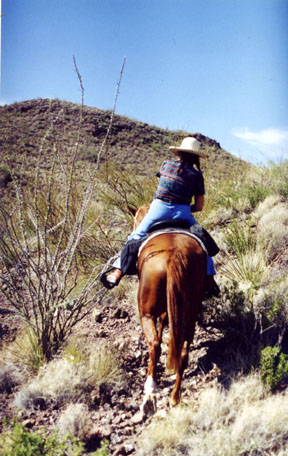
Photo by Steven Long, Horseback Magazine
AUSTIN, (TPWD) – The Texas Parks and Wildlife Department (TPWD) is continuing to explore the feasibility of non-lethal alternatives to manage the feral burro problem at Big Bend Ranch State Park.
Since the mid-2000s, TPWD’s State Parks Division has explored non-lethal options such as live trapping to remove the burros. State parks staff met early on with veterinarians and other experts with the USDA-Animal and Plant Health Inspection Service (APHIS) based in Presidio, but APHIS was unsuccessful in trapping feral burros along the US-Mexico Border within the state park.
In 2007, no feasible alternatives had been found and TPWD began lethal control. In 2008, the agency temporarily ceased lethal efforts to allow Peaceful Valley Donkey Rescue to try live trapping burros at the park, but after nearly two years of efforts by the group no burros were caught.
In 2011, TPWD Executive Director Carter Smith challenged critics of the department’s burro control methods to bring resources to bear on the problem and to suggest practical alternatives.
“We have said consistently that Texas Parks and Wildlife does not have the financial resources to control burros at Big Bend Ranch State Park through alternatives such as capture and quarantine, but that we are open to substantive discussions with interested parties who wish to offer their own resources to help address this problem,” Smith said. “However, any proposed plan must account for adequate and sustained funding, and we must be clear that the goal is to remove feral burros from the park.”
The Humane Society of the United States (HSUS) has offered its resources to assess non-lethal options. In January, state parks and HSUS staff met at Big Bend Ranch to allow HSUS to assess the landscape and conditions. HSUS is working with a private contractor to conduct an aerial survey to determine the numbers and locations of burros at the park, an essential first step to assess costs and feasibility of control options. TPWD has agreed to cost-share up to $10,000 to help pay for the survey, which should occur this spring.
If HSUS determines that non-lethal alternatives are feasible, the organization will prepare and submit to TPWD for its consideration a proposed timeframe, strategies, methods and resources required to accomplish non-lethal management alternatives. At present, there is no formal proposal or agreement between TPWD and HSUS.
“We understand concerns that have been expressed by many people and are open to considering feasible, non-lethal alternatives,” Smith said. “However, our basic policy is unchanged. Our responsibility to protect Big Bend Ranch State Park’s sensitive lands and waters is our highest priority. The need to control feral burros to protect park resources remains, and if non-lethal methods are determined to be unfeasible, we retain the option to conduct lethal control as conditions require.”
Smith said if HSUS is able to commit to adequate and sustained funding for burro control, and if the methods proposed by the humane society are accepted by TPWD, the agency will facilitate HSUS efforts by furnishing access, information and other available resources.
The burros are a feral, exotic, invasive species threatening the state park’s native plants and animals, precious desert springs and seeps, and other natural and cultural resources, a threat similar to that posed by feral hogs and other invasive plants and animals across Texas. TPWD has a statewide policy to control all such exotic, invasive plants and animals on its public lands. In 2011, the agency posted an online factsheet with photos and video detailing the park burro problem.
Removal of burros has been an opportunistic activity that occurs in the state park at times when visitor safety can be assured. The high season for BBR visitation is October-April. It is normal and customary for TPWD to curtail burro control during these months due to heavier public use in back country areas. Smith said it is not likely that TPWD will conduct lethal burro control in the near future, until it has been determined whether any non-lethal methods are feasible.









No comments:
Post a Comment